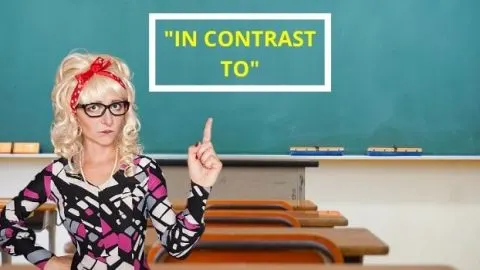English Grammar can be a tricky subject, tripping up even the best of us. It requires plenty of study and understanding.
But, once you get the hang of things, your words start flowing much more naturally, and you start making fewer and fewer mistakes.
One expression that can easily confound beginners to English is “in contrast to.” On the one hand, some people might not be sure what it means or how to use it in a sentence.
On the other hand, even if you know what it means, you still have to figure out how to punctuate it and what exact role it performs from a grammatical standpoint.
With this in mind, let’s take a closer look at “in contrast to.”
What does “in contrast to” mean?
When you use “in contrast to,” you are trying to highlight that one thing is very different from something else. It serves as a connector of contrast and leads back to causative conjunctions. (If this sounds confusing, it will be explained soon enough.) Interestingly, “in contrast to” can show up in different parts of a sentence, yet its function is usually the same throughout. The only exception to this is when “in contrast to” acts as an object of a verb.
You should also know that a valid alternative to “in contrast to” is “in contrast with.”
Understanding the grammar
If we break down “in contrast to,” we will find that it consists of two prepositions and one noun. You have the preposition “in,” followed by the noun “contrast,” followed by the preposition “to.”
This breakdown is important because we will later look at what happens when “contrast” acts as a verb.
“In contrast to” is always followed by a noun.
Here are a few examples to get the ball rolling.
The sentence here makes two assertions. On the one hand, it tells us that the main subject isn’t athletically gifted. On the other hand, it also informs us that his brother is gifted athletically.
Here, “in contrast to the movie” is an interjectory statement that adds unnecessary information to the sentence.
Conjunctions
There are several types of conjunctions.
You have coordinating conjunctions, which include “and,” “or,” and “so.” You have subordinating conjunctions, which tie a subordinate clause to an ordinate one and include “while,” “even though,” and “although.”
You also have conjunctive adverbs, such as “however,” “finally,” and “in contrast to.”
Now, conjunctive adverbs help show us the relation between two clauses. The relationship could be one of conclusion, in which case you probably want to use words like “to conclude,” “briefly,” and “as a result.”
If the relationship is that of addition, you will end up using words like “Additionally,” “over and above,” and “What’s more.”
Alternatively, if you want to highlight a relation of cause and effect, then you need to use adverbs like “consequently,” “accordingly,” and “hence.”
Fourth on the list is a relation of opinion, where you will use words like “to my mind,” in my opinion,” and “as I see it.” Finally, there are connectors of contrast, and these include “nevertheless,” “despite,” and “in contrast to.”
Here are five examples highlighting each type of conjunctive adverb.
Before moving on, it is worth highlighting that the conjunctive adverbs mentioned above, come in one of two flavors.
Either you have a direct adverb as was the case with “consequently” and “additionally,” or you have a prepositional phrase as was the case with “to my mind” and “in contrast to.”
So, to sum up everything said so far, “in contrast to” is a prepositional phrase that behaves as a conjunctive adverb highlighting a relation of contrast.

How do you punctuate conjunctive adverbs?
As mentioned earlier, conjunctive adverbs show the relation between two ideas.
Now, a conjunctive adverb can come in different positions.
It can introduce a sentence.
It can come in the middle or the end of a sentence.
It can tie two main clauses together using a semicolon.
Conjunctive adverbs to introduce sentences
When conjunctive adverbs come at the beginning of a sentence, they are always followed by a comma.
Conjunctive adverbs in the middle or the end of a sentence
When a conjunctive adverb comes in the middle of a sentence, it is usually surrounded by a comma on either side because it plays an interjectional role.
And, if the conjunctive adverb comes at the end of a sentence, it is preceded by a comma and followed by a full stop.
Conjunctive adverbs tying two independent clauses with a semicolon
In this case, the conjunctive adverb is preceded by a semicolon and followed by a comma.
It is worth noting when using “in contrast to” to tie two clauses together, the noun at the end should refer to the first clause.
So, in our example, we used the word “this.” Another possibility was as follows.
”In contrast to” as an object
Aside from functioning as a conjunctive adverb, “in contrast to” can also be the object of a verb, in which case it takes no punctuation whatsoever.
As you can see, since “in contrast to” is a direct object in both of the above examples, it requires no special punctuation around it.
The difference between “in contrast to” and “in contrast with”
For the most part, “in contrast to” and “in contrast with” mean the same thing and are interchangeable.
That said, there are a few things worth pointing out.
First of all, “in contrast to” is significantly more popular than “in contrast with.”
As a matter of fact, according to the Corpus of Contemporary American English, “in contrast to” is more than ten times more popular than “in contrast with.”
Similarly, the Google Ngram Viewer tells us the same fact, that “in contrast to” is far more widely used than “in contrast with.”
Nevertheless, it is also worth noting that the Google Ngram viewer also tells us that there was a point in time, around the nineteenth century, when things were the other way around and “in contrast with” was more popular than “in contrast to.”
The other thing that I would like to highlight is that there is an alternative usage of “contrast with,” one that sees “contrast” being used as a verb rather than a noun.
In this particular case, you can substitute “contrast with” with “contrast to.”

Hey fellow Linguaholics! It’s me, Marcel. I am the proud owner of linguaholic.com. Languages have always been my passion and I have studied Linguistics, Computational Linguistics and Sinology at the University of Zurich. It is my utmost pleasure to share with all of you guys what I know about languages and linguistics in general.

